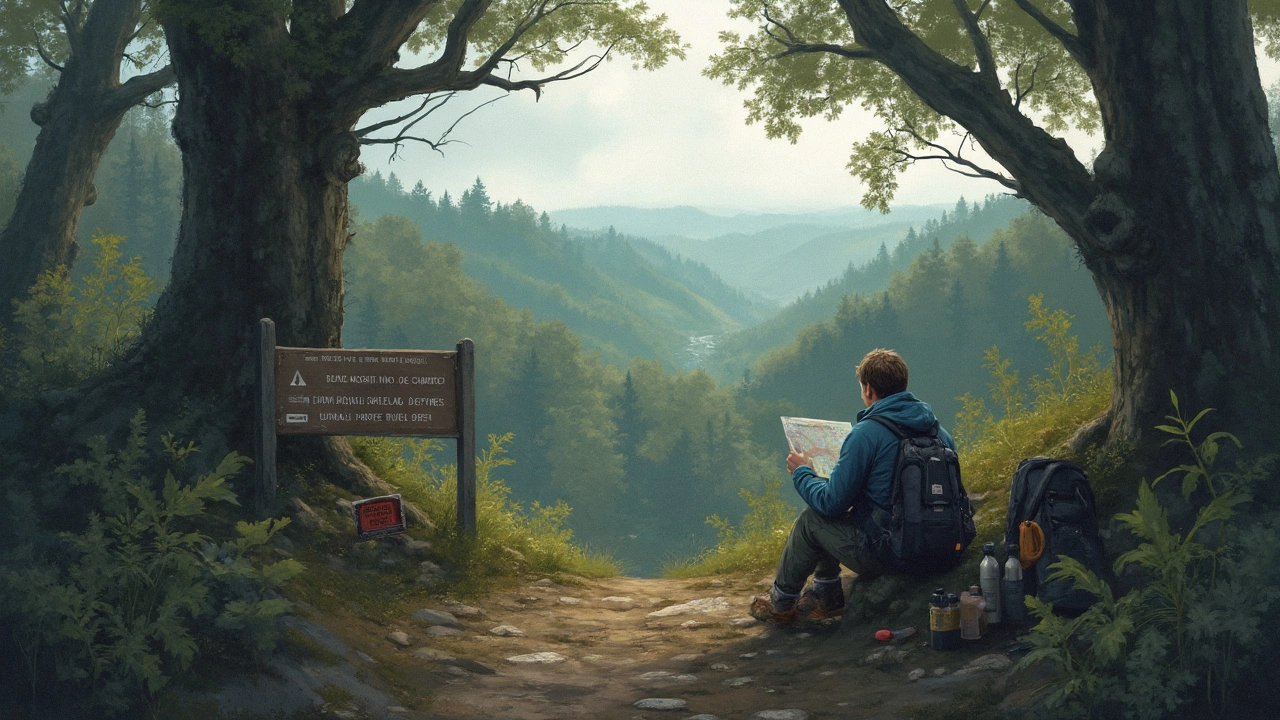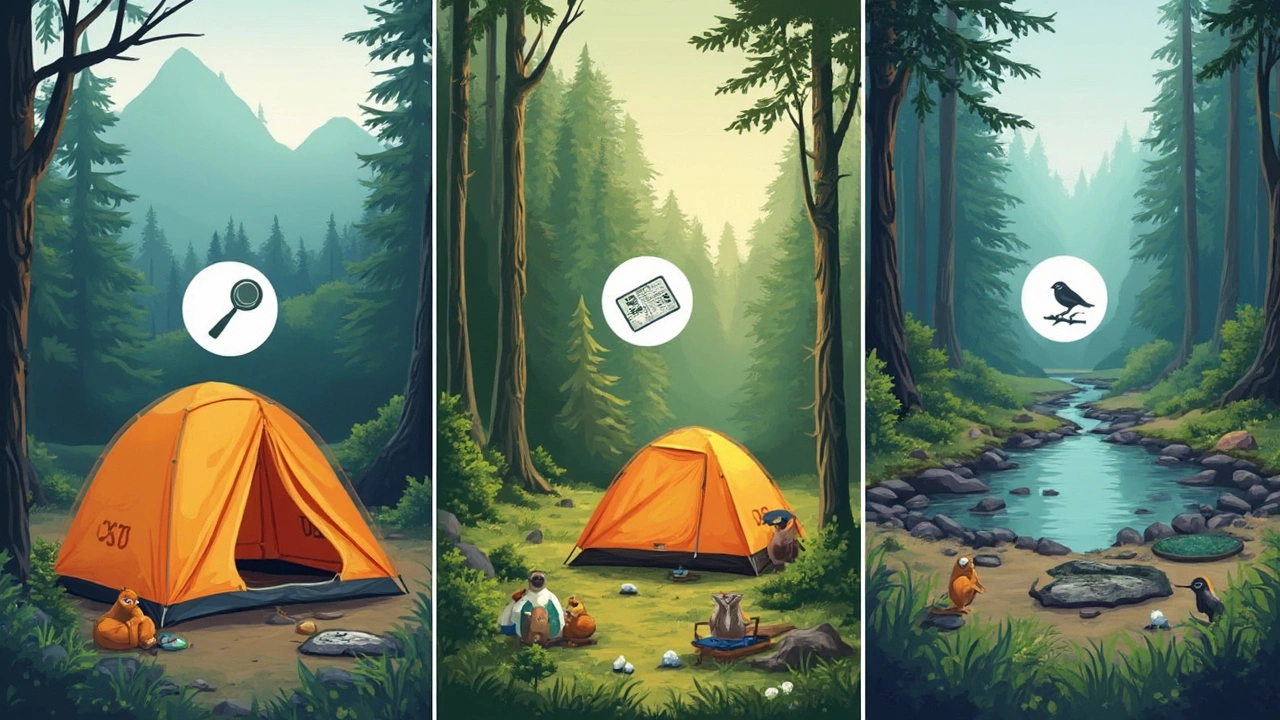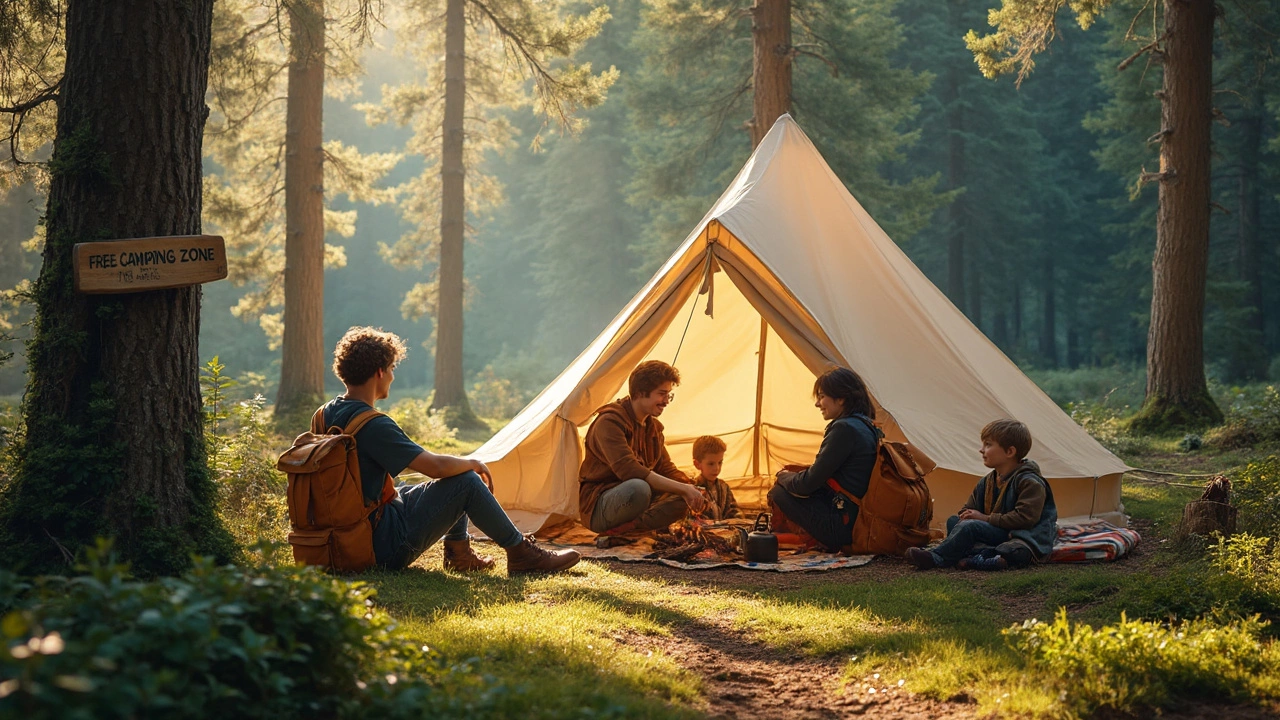People love the idea of camping for free, but most don’t realize it actually exists—legally—all across America. If you know the rules and where to look, you can pitch your tent deep in a forest, wake up to birds instead of city traffic, and pay nothing for the spot. Free camping, usually called dispersed camping, is legal on most public lands managed by the U.S. Forest Service and Bureau of Land Management (BLM). The catch? You have to follow a few simple rules, and not every state makes it equally easy.
The western states are famous for free forest campsites. Think Colorado, Utah, Idaho, Montana, Oregon, Washington, Arizona, New Mexico, and California. They’re packed with national forest land where you can just pull off a forest road, set up, and relax. In the eastern half, spots are scarcer but not impossible to find—look at Maine’s North Woods, Michigan’s Upper Peninsula, and parts of Pennsylvania if you want a free forest escape. Some southern and Midwestern states also have hidden patches of national forest that let you camp for free if you know where to look.
Here's the thing: the experience is totally different from paid campgrounds. You won’t find picnic tables, bathrooms, or marked sites. You need to be a bit more self-reliant, pack your trash out, and keep your fire under control. But the payoff? Nobody next door, zero fees, and some of the best forest views out there. Ready to see which states really let you camp for free and how not to mess it up? Read on and you’ll have everything you need to get started.
- What Free Camping in Forests Really Means
- States Where Forest Camping is Free
- Rules and Limits to Watch Out For
- Tips for a Solid Free Camping Experience
- Hidden Gems and Common Mishaps
What Free Camping in Forests Really Means
Free camping in forests isn’t some wild loophole or camping hack—it’s actually a legit system the U.S. Forest Service and Bureau of Land Management set up ages ago. This kind of camping is called dispersed camping, and it means you’re camping anywhere outside of a developed campground. You pick a legal spot, usually anywhere at least 100 to 200 feet from water sources, trails, and roads. Not every forest allows it, but most National Forest Lands west of the Mississippi, plus much of the BLM land, make it possible.
If you want to camp for free, the main thing to look for is public land. State and local parks almost always charge fees, but wide stretches of federal forest land—especially in states packed with National Forests like Colorado or Montana—give you true free camping options. You won’t get extras like toilets or firewood, but you won’t get a bill either.
The rules are simple: Leave No Trace, which just means don’t mess the place up. That includes packing out everything, including your trash, and being extra careful with fires. Most spots have a limit—usually 14 days in one place—before you need to move at least five miles away. Rangers check up now and then, so don’t think these rules are just for show.
- Stay limits: Typically 14 days in one spot, sometimes less. Some places rotate this to avoid people turning these free sites into their backyard.
- Location: Camp at least 100-200 feet away from lakes, streams, or rivers to avoid contaminating water and bothering wildlife.
- No facilities: Bring your own toilet setup or learn the cat-hole method. Don’t expect fresh water or trash cans.
Some areas do require a free permit, like parts of California’s national forests during fire season. A quick stop at the local ranger station or a check on official forest websites usually sorts that out in a couple of minutes. If a spot looks super popular, assume you’re not the first one there—so tread lightly and try not to add to the mess.
States Where Forest Camping is Free
Let’s get to it—if you’re after free camping in forests, you have real options across the country, especially in the West. Out west, most national forests in states like Colorado, California, Montana, Idaho, Oregon, Washington, Utah, Arizona, and New Mexico let you camp for free on millions of acres. The U.S. Forest Service calls this "dispersed camping," meaning you set up outside of developed campgrounds. The rules are usually simple: pick a spot at least 100-200 feet from water sources and trails, stay a max of 14 days in one spot, and definitely don’t leave trash behind.
Here’s a quick breakdown of where it’s easiest to camp for free in the forests:
- Colorado: Almost every national forest allows dispersed camping. Try Arapaho, San Isabel, or Pike National Forest if you want classic mountain scenery.
- California: Forests like Inyo, Stanislaus, and Los Padres offer free camping, but you need to grab a free fire permit for campfires and stoves. Check road conditions—you do not want to get stuck.
- Montana: You have your pick of the Bitterroot, Custer-Gallatin, and Flathead forests. Just watch the weather: Montana can get cold, fast.
- Idaho: Spots in the Sawtooth and Panhandle forests are straight-up beautiful and usually empty during weekdays.
- Utah, Arizona, and New Mexico: These states are goldmines for free forest camping, especially near Sedona, Flagstaff, the White Mountains, and the Manti-La Sal. Fire bans get strict here in summer—keep it safe.
- Oregon and Washington: Mt. Hood and Gifford Pinchot forests are popular. Get there early during peak season; locals know all the best spots.
Now, if you head east, it gets more competitive. The land is more chopped up, but Michigan offers free camping in Hiawatha and Ottawa National Forests, while Pennsylvania’s Allegheny National Forest has a mix of first-come, first-served spots. Maine’s North Woods has scattered backcountry sites that don’t cost a dime, especially during spring and fall.
Here’s a pro tip: Always double-check with the closest ranger station or the official Forest Service website, because rules can change with fire danger, seasons, or local regulations. Some forests only allow camping in certain corridors or have permit requirements. Don’t assume you can pull off anywhere—make sure you’re on national forest land, not private property or state parks, which usually have different rules and sometimes hefty fines.
Bottom line: With a little homework, you can throw down your tent or park your rig for free in dozens of states, mostly on public land managed by the Forest Service. The real secret? Don’t rely just on Google Maps—get actual forest maps or a GPS app like Gaia or USFS Map. Free forest camping is waiting for anyone willing to get a bit off the usual path.

Rules and Limits to Watch Out For
Free camping on forest land sounds super chill, but there are rules you really can’t ignore—unless you want to end up with a fat fine or a ranger knocking on your tent. The main rules come from the U.S. Forest Service, and they’re pretty much the same across the country with some local twists. It’s all about taking care of the land and avoiding dangerous situations.
First up, almost all national forests have a stay limit. Usually, you can only camp in the same spot for 14 days in a 30-day period. After that, you’ve got to move, typically at least 25 miles away. Don’t try to sneak the system—rangers do check, and they keep notes if they spot you hanging around too long.
Don’t expect fancy setups or marked sites at free camping spots. You need to pick an existing spot or camp on bare ground to avoid damaging plants. Dig a “cathole” for bathroom breaks at least 200 feet from any water or trail (yep, bring a shovel). Fires are cool in most places unless there’s a ban—that happens when it’s really dry, and fire bans are serious business. Always use old fire rings if they're there, and drown your fire dead when you leave.
You can’t just roll up to every lake, river, or trailhead and call it a free site. There are "no camping" signs and rules near certain recreation areas or private land. Always check local forest office maps and bulletins. Some places shut down access in winter or after big storms, so double-check road conditions or you might find yourself stranded.
- Pack out all your trash. Littering is the fastest way to lose camping privileges for everyone.
- Keep your site quiet—loud noise can get you kicked out and ticks off nearby campers and wildlife.
- Respect wildlife. Don’t feed animals and always hang your food, especially in bear country.
- Group size matters: Most forests cap it at 8-12 people per site. If you’ve got a big crew, better split up.
- Vehicles must stay on roads—don’t try to make your own path through the forest. You’ll kill plants and that’s a big no-go.
One more tip: cell service is spotty at best in most forest campsites. Let someone know where you are in case you run into trouble, and always keep a paper map handy.
Tips for a Solid Free Camping Experience
Want to actually enjoy your time out in the woods? Here’s how to make sure your free camping trip goes smoothly. Some folks wing it and end up soaked, hungry, or flagged down by a ranger. Don’t be that person. Start with solid prep, because there’s no office on-site to help you out if you forget the basics.
- Check the forest rules: Not every patch of national forest land allows camping, and even the ones that do often have stay limits (usually 14 days in one spot). Look up the specific forest’s website before you leave—seriously, some areas close during fire season, and others require free permits.
- Scout your spot on a map: Use apps like iOverlander or FreeRoam to spot places other campers use. Download offline maps since cell service drops as soon as you get deep enough for real peace and quiet.
- Pack in what you need, take out what you brought: There are no trash cans or water spigots—so bring enough food, pack extra water (a gallon per person per day is a good benchmark), and carry out every scrap of trash.
- Handle your bathroom needs smart: A surprising number of people skip this—bring a portable toilet, or at the very least, a small shovel to dig a six-inch cathole at least 200 feet from water sources. Some national forests actually require you to pack out all waste.
- Keep fires safe: Wildfire risk is real, especially out West. Always check restrictions before you start a campfire, and use a portable stove if a fire ban’s on. If fires are allowed, use only existing fire rings and keep a bucket of water handy.
- Respect wildlife: Don’t feed animals, and store food in your car or bear-proof canisters if you’re in bear country. Raccoons, squirrels, and mice get into anything.
- Stay on old campsites: Pitch your tent where the ground’s already worn. This reduces impact on fresh vegetation—some rangers will check, and you don’t want a ticket.
- Leave your spot cleaner than you found it: It’s the unspoken rule. Pick up other folks’ trash, if you see it—keeps these places free for everyone.
Just to give you an idea of what you’ll need, here’s a quick look at what most experienced campers recommend bringing along for free forest camping:
| Must-Have Gear | Why It Matters |
|---|---|
| Plenty of water & purification system | No tap water in most free spots, and streams aren’t always safe |
| Trash bags | Pack out everything, always |
| Headlamp/flashlight with backup batteries | Pitch dark nights, especially under tree cover |
| First aid kit | Small accidents get bigger without quick help |
| Multi-tool/knife | Cutting rope, food prep, repairs—super handy |
| Map and compass/GPS device | Getting lost is easier than you think |
If you're nervous about your first go, start near a forest road or stick to busier free camp zones. You'll pick up tricks fast, and soon trying something wilder won’t feel so intimidating. Nobody’s born a pro at roughing it, but it gets easier—and way more fun—every time you try. Stay safe, respect the land, and the adventures just keep coming.

Hidden Gems and Common Mishaps
Finding a free forest campsite feels like hitting the jackpot, but not every great spot is on a popular website or comes with a sign. In Idaho, for instance, the Sawtooth National Forest has quiet pull-offs along forest roads that nobody talks about online. In Arizona, north of Sedona, there’s a patch on Forest Road 525 that lets you crash with red rock views for nothing. Oregon’s Umpqua National Forest has miles of backroads dotted with clearings you can call home for a night or two. If you’re ever in Michigan’s Ottawa National Forest, the Upper Peninsula’s out-of-the-way clearings near Lake Superior are rarely occupied and wild as can be.
Here’s a quick look at some top states with awesome but less-known free camping picks:
| State | Hidden Forest Spot | Cool Feature |
|---|---|---|
| Idaho | Little Casino Creek pullouts, Sawtooth NF | Mountain views, usually empty |
| Montana | Gallatin NF north of Big Sky | Quiet, great wildlife spotting |
| California | Eldorado NF, Ice House Road pullouts | Shaded forest, near lakes |
| Pennsylvania | Allegheny NF, Hearts Content area | Old-growth forest, rarely busy |
The downside? Because these places are not managed like regular campgrounds, you’re on your own if you have issues. Getting stuck on a muddy forest road is more common than you think, especially after rain. Once in Colorado, I watched a pickup spend two hours digging out after trying to take a shortcut through what looked like solid dirt. Cell service can vanish for miles. If you rely on your phone for maps or weather, load up everything offline before leaving pavement.
Let’s talk about mistakes to avoid. Folks often forget these basics:
- Ignoring stay limits: Most forests cap free camping at 14 days in one spot. Staying longer can land you with a fine.
- Leaving trash: These sites have zero maintenance. Pack out all your waste, even stuff like apple cores or used wipes.
- Getting too close to water: Camping right on a lakeshore or riverbank can wreck fragile ecosystems. Keep at least 200 feet back.
- Lighting fires in the wrong season: Forest fire danger is real, especially in places like California or New Mexico. Always check if fires are allowed and never leave one smoldering.
To cut down on surprises, pay attention to local ranger stations for current road conditions and fire updates. If you want to avoid rookie mistakes, there’s no shame in asking locals—other campers usually spill their favorite hidden gems for the price of a friendly chat. Your best free campsite story starts with a little prep and a lot of common sense.
